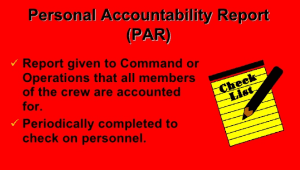
Personnel Accountability Reports (PARs) are essential to helping commanders develop and maintain situational awareness. A quality PAR dials the commander into every crew’s size, their location and their progress. But the standard PAR has a fundamental flaw that can adversely impact the commander’s situational awareness. Here’s how…
Summertime can bring excessive heat and humidity to many regions. When weather is severe, first response personnel can be especially vulnerable to heat-related medical emergencies. It is possible that crews heavily focused on task performance may not be aware of how the heat is impacting them.
In excessive weather, a standard roll-call PAR may not be sufficient if it only assesses crew size, location and task performance/progress. Crews suffering physically from outside heat may find themselves affirming PAR without thinking about how the heat has impacted their stamina. Even if they are aware of how the heat has impacted them, the standard PAR provides no way for the crew to tip command on their condition.
Chief Gasaway’s Advice
 In excessive heat the standard radio roll-call PAR may not effectively assess the physical well-being of crews. When a crew acknowledges PAR, it speaks nothing to their welfare (physical condition and stamina).
In excessive heat the standard radio roll-call PAR may not effectively assess the physical well-being of crews. When a crew acknowledges PAR, it speaks nothing to their welfare (physical condition and stamina).
It may be beneficial to ask safety officers to conduct a “Walking Par” and visually assess each firefighter’s well-being with their own eyes.
Alternatively, PAR reports could include a code that indicated the crew’s physical well-being. For example:
Green: Crew is in an excellent state of readiness.
Yellow: Crew has been actively performing high-stress tasks and has reduced stamina.
Red: Crew has been extensively performing high-stress tasks and has little stamina remaining.
Command conducting a PAR might hear reports like this:
Engine 101, PAR, Crew of 4 green, second floor, attacking the fire.
Truck 302, PAR, crew of 4. 2 green, 2 yellow, third floor conducting a search
Squad 211, PAR, crew of 4 yellow, on the first floor conducting a search.
Engine 17, PAR, crew of 4 red, in staging.
There are 6 firefighters at full-stamina, 6 firefighters running on half-stamina, and 4 firefighters who are, essentially, out-of-service.
A system (like color coding) could tell the commander a whole lot more about the physical stamina of crews, improving the commander’s situational awareness.
Discussion Questions
 1. Does your department have a process to assess the physical well-being of personnel operating in high-stress, high-consequence environments?
1. Does your department have a process to assess the physical well-being of personnel operating in high-stress, high-consequence environments?
2. What can you do to ensure the well-being of personnel during periods of excessive weather?
3. In addition to a Walking Par or a coding system, how can the well-being of firefighters be assessed?
_____
NOTE: This contribution was inspired by SAMatters member Fire Chief Dan Rhodus of the Lenexa (Kansas) Fire Department** who shared with me a story of their success with the Walking PAR at a four-alarm structure fire on a day where the heat index reached 138 degrees.
** In December 2010 I conducted a multi-day situational awareness and decision making program for the Lenexa Fire Department and was very impressed with their focus on firefighter safety and their commitment to developing high quality commanders.
_____________________________________________________________
The mission of Situational Awareness Matters is simple: Help first responders see the bad things coming… in time to change the outcome.
Safety begins with SA!
_____________________________________________________________
Share your comments on this article in the “Leave a Reply” box below. If you want to send me incident pictures, videos or have an idea you’d like me to research and write about, contact me. I really enjoy getting feedback and supportive messages from fellow first responders. It gives me the energy to work harder for you.
Thanks,

Email: Support@RichGasaway.com
Phone: 612-548-4424
Facebook Fan Page: www.facebook.com/SAMatters
Twitter: @SAMatters
LinkedIn: Rich Gasaway
YouTube: SAMattersTV
iTunes: SAMatters Radio


Great collaborative article chiefs! Impressive to see our leaders sharing turf. The walking par is effective when a safety officer can walk around, look those firefighters in the eyes and see how they are really doing, look at their posture, look for despair or other indications of the “situation.” Command should consider using the safety officer for this assignment in order to receive an accurate report back. Thanks again chiefs.